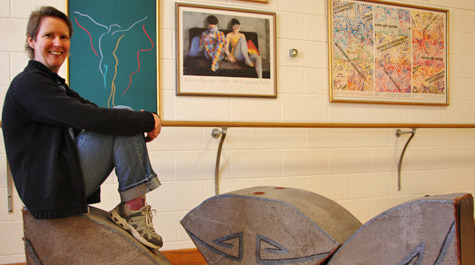Dance, art professors collaborate on 'Symbol'
For some William & Mary professors, research consists of sitting at a desk poring over academic papers or sitting in a lab conducting science experiments. But as Professor of Dance Joan Gavaler shows through her latest piece, entitled “Symbol,” research at the College doesn’t always come with hypotheses and conclusions.
“Symbol,” a joint collaboration between Gavaler, Professor of Art Elizabeth Mead, and two musicians, is a modern-dance piece depicting a ritual cycle that embodies loss and regeneration. Performed for the first time in fall 2008 at Phi Beta Kappa Memorial Hall, “Symbol” is one of approximately 40 works that will be showcased in a festival sponsored by the American Dance Guild Feb. 24-27 at Manhattan Movement and Arts Center.
{{youtube:medium:left|5PafYVC60gI}}
“The American Dance Guild is dedicated to supporting artists and bringing the dance community together,” Gavaler said. “Usually, 150 or so choreographers apply to the festival, and I’m so pleased that “Symbol” has been chosen to be included so that the artistic work of the W&M faculty can be shared more broadly.”
The performance, which consists of Gavaler creating movements with a single wheel-shaped object features music reflective of Mayan, Taino, and Christian symbols. Throughout the performance, she rearranges the wheel, which splits into four sections, to create several formations, each targeted to exude certain symbolism and messages for the audience.
“The choreography, with the re-arranging of the sculpture, embodies the ideas of mythological worlds being created, destroyed, and recreated,” Gavaler said. “Those symbols remind us of the cultural destruction experienced by native peoples of the Americas when Europeans arrived. But out of loss, there can also be regeneration.”
To Mead, who created the wheel that Gavaler uses, the idea of collaboration between two distinct styles of art is key to the success of this performance.
“While the qualities and tendencies of each individual are present at every moment in the collaborative process and in the final product, the unique way that these individual qualities and tendencies come together make them different this time around,” Mead said. “These unexpected possibilities are what I find most interesting, and it is these possibilities that are the true “product” of collaboration.”
When Mead was first approached with the opportunity to create Gavaler’s wheel, she wanted to create something that would address all of the needs of the performance, and would mesh seamlessly into the performance as a whole.
“I have done my job correctly if the audience walks out talking about the performance as a whole,” Mead said. “If they are talking about any one element over another, then something is not fulfilling its obligation to the project. Every aspect of the work should come together seamlessly.”
For Gavaler, this performance represents a collaborative piece of research for the fine arts -- a far cry from the traditional view that research should be done with pencil to paper.
“Art is not always from a verbal place,” she said. “Choreography and performance are my research areas as a practicing artist at William & Mary. As a choreographer, I am creating original works that explore many different concepts and movement experiments. Publication of that research is through public performances.”
Yet Gavaler also sees “Symbol” as a vehicle that transports the audience on an expedition into the world of loss and regeneration.
“This piece is, in many ways, performed as a ritual,” Gavaler said. “I am aware of the task before me, and try to fulfill my movements and the reconstructing of my ‘worlds’ with a sense of reverence. I invite the audience to come with me on the journey.”
 Skip to main content
Skip to main content

